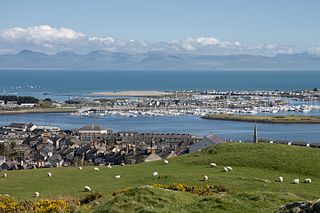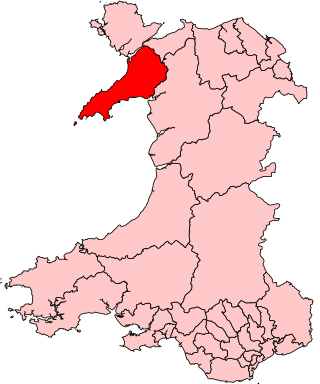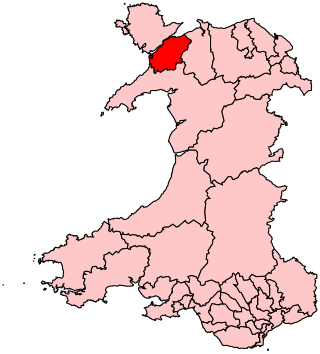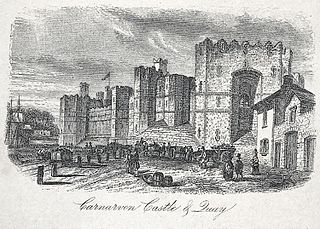Related Research Articles

Caernarfon is a royal town, community and port in Gwynedd, Wales. It has a population of 9,852. It lies along the A487 road, on the eastern shore of the Menai Strait, opposite the island of Anglesey. The city of Bangor is 8.6 miles (13.8 km) to the north-east, while Snowdonia (Eryri) fringes Caernarfon to the east and south-east.

Gwynedd is a county in the north-west of Wales. It borders Anglesey across the Menai Strait to the north, Conwy, Denbighshire, and Powys to the east, Ceredigion over the Dyfi estuary to the south, and the Irish Sea to the west. The city of Bangor is the largest settlement, and the administrative centre is Caernarfon. The preserved county of Gwynedd, which is used for ceremonial purposes, includes the Isle of Anglesey.

Porthmadog, originally Portmadoc until 1974 and locally as "Port", is a coastal town and community in the Eifionydd area of Gwynedd, Wales, and the historic county of Caernarfonshire. It lies 5 miles (8 km) east of Criccieth, 11 miles (18 km) south-west of Blaenau Ffestiniog, 25 miles (40 km) north of Dolgellau and 20 miles (32 km) south of Caernarfon. The community population of 4,185 in the 2011 census was put at 4,134 in 2019. It grew in the 19th century as a port for local slate, but as the trade declined, it continued as a shopping and tourism centre, being close to Snowdonia National Park and the Ffestiniog Railway. The 1987 National Eisteddfod was held there. It includes nearby Borth-y-Gest, Morfa Bychan and Tremadog.

Until 1974, Caernarfonshire, sometimes spelled Caernarvonshire or Carnarvonshire, was an administrative county in the north-west of Wales, later classed as one of the thirteen historic counties of Wales.

Pwllheli is a market town and community of the Llŷn Peninsula, north-western Wales. It lies in the traditional county of Caernarfonshire, but is currently administered as part of the unitary authority of Gwynedd. It had a population of 4,076 in 2011 of whom a large proportion, 81%, are Welsh speaking. Pwllheli is the place where Plaid Cymru was founded. It is the birthplace of the Welsh poet Sir Albert Evans-Jones.

Caernarfon was a parliamentary constituency centred on the town of Caernarfon in Wales. It elected one Member of Parliament (MP) by the first past the post system.

Arfon is a constituency in Wales represented in the House of Commons of the UK Parliament at Westminster. Although it is relatively large by geographical area, the constituency is a predominantly urban rather than rural seat, with the majority of the population living in the two towns of Bethesda and Caernarfon, as well as in the city of Bangor, on which the constituency is based. "Arfon" is a historical name for the area, meaning "facing Anglesey"; it is also the name of the former district council. This seat was created by the Welsh Boundary Commission in time for the 2010 general election; it replaced the old seat of Caernarfon. Bangor was in the old seat of Conwy. The same boundaries were used for the Arfon Welsh Assembly constituency in the 2007 Welsh Assembly election.

North Wales Police is the territorial police force responsible for policing North Wales. Its headquarters are in Colwyn Bay. As of March 2020, the force has 1,510 police officers, 170 special constables, 182 police community support officers (PCSO), 71 police support volunteers (PSV), and 984 staff.

The Police Act 1946 was an Act of Parliament of the Parliament of the United Kingdom that provided for the amalgamation of smaller borough police forces with county constabularies in England and Wales, allowed for the merger of county forces in certain circumstances and changed the boundaries of the Metropolitan Police District.
The office of High Sheriff of Gwynedd was established in 1974 as part of the creation of the county of Gwynedd in Wales following the Local Government Act 1972, and effectively replaced the shrievalties of the amalgamated counties of Anglesey, Caernarfonshire and Merionethshire.
Denbighshire Constabulary was the Home Office police force for the county of Denbighshire, Wales from 1840 until 1967.
This article is about the particular significance of the year 1862 to Wales and its people.
Flintshire Constabulary was the Home Office police force for the county of Flintshire, Wales, from 1856 until 1967.
Sir Hugh John Ellis-Nanney, 1st Baronet, was a Welsh landowner, magistrate and political candidate.
Carnarvon (Pant) was the temporary northern terminus of the Carnarvonshire Railway, located on the southern fringe of Caernarfon, Gwynedd, Wales.

Carnarvon Castle railway station was opened in 1856 by the narrow gauge Nantlle Railway near the foot of what is today the Allt Y Castell which slopes down to Caernarfon's harbour area. It was the line's northern terminus and was the closest of Caernarfon's ultimately five stations to the historic town centre.

The Council Offices is a municipal facility at Shirehall Street in Caernarfon, Wales. The structure, which is the headquarters of Gwynedd Council, is a Grade II listed building.
Merionethshire Constabulary was the Home Office police force for the county of Merionethshire, Wales from 1856 until 1950.
Anglesey Constabulary was the Home Office police force for the county of Anglesey, Wales from 1856 until 1950.
References
- 1 2 Jones, J. Owain (1963). The History of the Caernarvonshire Constabulary, 1856–1950. Caernarfon: Caernarvonshire Historical Society, Gwenlyn Evans, Ltd. p. 90.
- ↑ Jones. History of the Caernarvonshire Constabulary. pp. 15–27.
- ↑ "Caernarvonshire Constabulary: British Police History". british-police-history.uk. Retrieved 2022-10-28.
- 1 2 "Records of the Caernarvonshire Constabulary - Archives Hub". archiveshub.jisc.ac.uk. Retrieved 2022-10-28.
- ↑ Jones. History of the Caernarvonshire Constabulary. pp. 78–79.